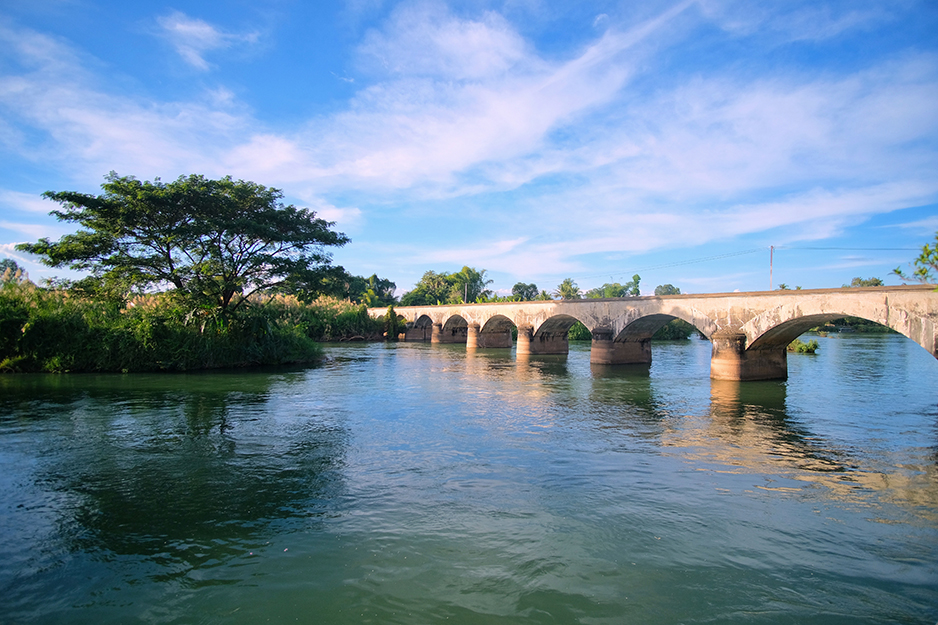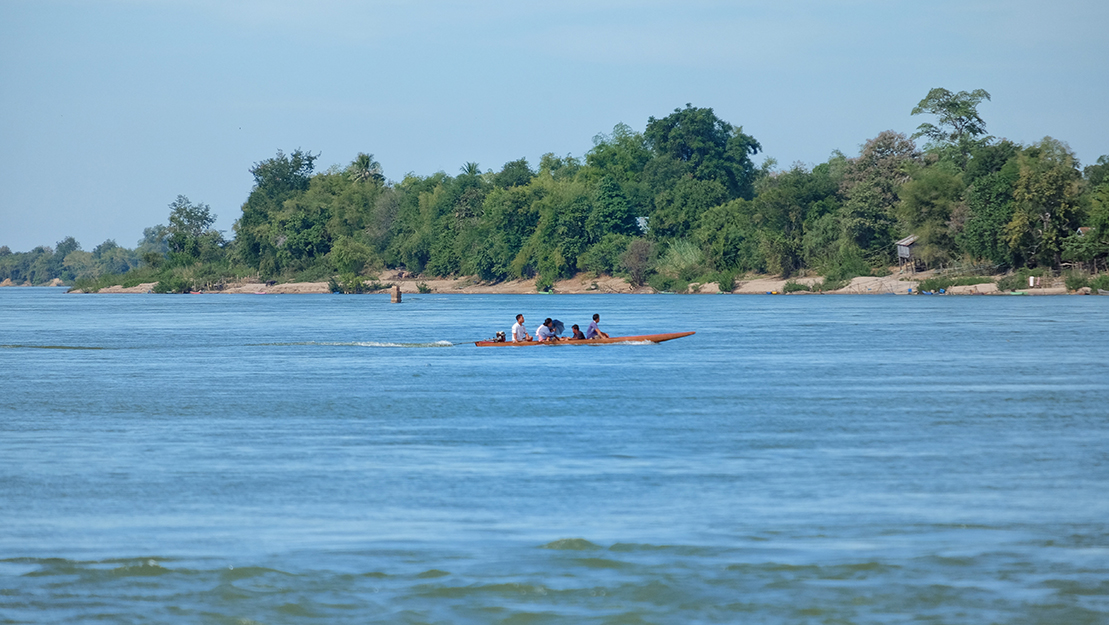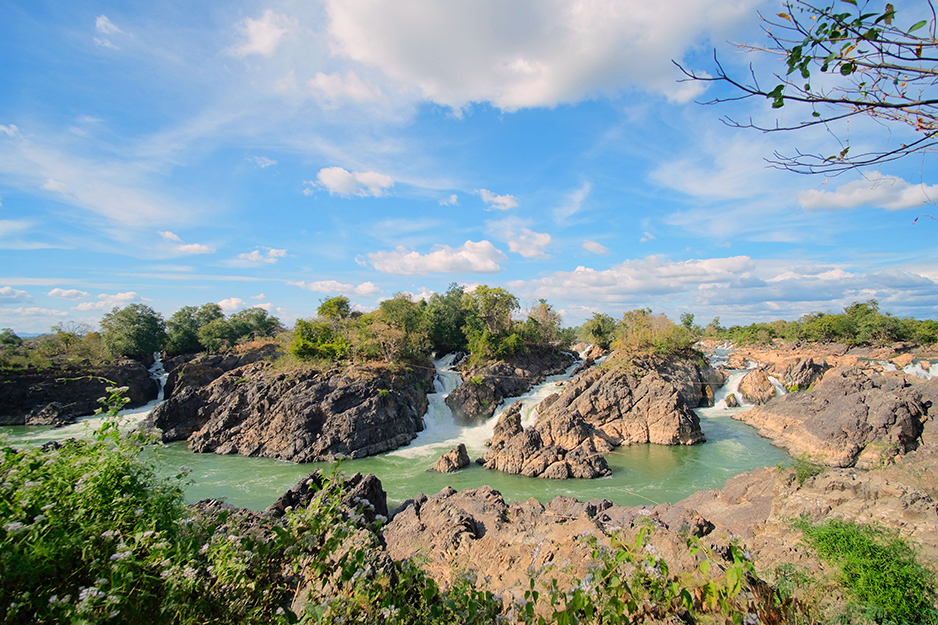ພະຈົນໄພທີ່ໃຕ້ສຸດຂອງລາວ
ຫາກເບິ່ງຢູ່ເທິງແຜນທີ່, 4000 ດອນ ປຽບສະເໝືອນກັບເປັນຂອດເຊືອກໃຫຍ່ຂອງແມ່ນໍ້າຂອງທີ່ຜູກຕິດຊາຍແດນລາວ ແລະ ກຳປູເຈຍໄວ້ນໍາກັນ. ບັນດານັກທ່ອງທ່ຽວມັກຈະເວົ້າເຖິງເຂດໃຕ້ສຸດຂອງປະເທດລາວວ່າເປັນບ່ອນທີ່ສວຍງາມ, ງຽບສະຫງົບ ແລະ ມີວິຖີ ຊີວິດແບບຄ່ອຍເປັນຄ່ອຍໄປ. ຜູ້ຄົນຈາກຫຼາກຫຼາຍພື້ນທີ່ລ້ວນແລ້ວແຕ່ມາພັກຜ່ອນຢູ່ສະຖານທີ່ແຫ່ງນີ້ເປັນເວລາຫຼາຍເດືອນຕິດຕໍ່ກັນ. ເມື່ອທ່ານມາຮອດ, ທ່ານອາດຈະບໍ່ຕ້ອງການຈາກສະຖານທີ່ແຫ່ງນີ້ໄປອີກເລີຍ. ມີຜູ້ໜຶ່ງໄດ້ເວົ້າໄວ້ວ່າ “ມັນຄ້າຍຄືກັບ ເມືອງ ວັງວຽງ ເມື່ອຊ່ວງ 20 ປີກ່ອນ.” ຍ້ອນບັນດາເກາະດອນທີ່ກະຈາຍໄປຕາມໄລຍະ 14 ກິໂລແມັດຂອງແມ່ນໍ້າຂອງ, ການທີ່ຍັງບໍ່ທັນໄດ້ຮັບການພັດທະນາ (ບໍ່ມີລົດໃຫຍ່ຢູ່ເທິງດອນເລີຍ), ຜູ້ຄົນທ້ອງຖິ່ນທີ່ເປັນມິດ, ທຳມະຊາດທີ່ໜ້າປະທັບໃຈ ແລະ ທີ່ພັກເຊົາໃນລາຄາຖືກ ຈຶ່ງສາມາດເຂົ້າໃຈໄດ້ເລີຍວ່າເປັນຫຍັງຄົນຈຶ່ງມັກສະຖານທີ່ແຫ່ງນີ້. ເຊິ່ງໜ້າແປກໃຈສຳລັບໜຶ່ງໃນສະຖານທີ່ທີ່ໄດ້ຮັບການພັດທະນາໜ້ອຍທີ່ສຸດໃນລາວ, ພື້ນທີ່ດັ່ງກ່າວແມ່ນໜຶ່ງໃນບັນດາພື້ນທີ່ທຳອິດທີ່ນັກສຳຫຼວດໄດ້ເຂົ້າມາຢ້ຽມຊົມ. ຄະນະກຳມະການສຳຫຼວດແມ່ນໍ້າຂອງທີ່ໄດ້ຮັບການສະໜັບສະໜູນຈາກປະເທດຝຣັ່ງໃນຊຸມປີ 1860 ຖືເປັນການສໍາຫຼວດດ້ານວິທະຍາສາດຄັ້ງທຳອິດທີ່ໄດ້ເຂົ້າມາບັນທຶກ ແລະ ສຳຫຼວດຄວາມຍາວຂອງແມ່ນໍ້າຂອງ. ຈຸດປະສົງຕົ້ນຕໍຂອງພວກເຂົາແມ່ນເພື່ອຊອກຫາເສັ້ນທາງ ທາງບົກທີ່ສາມາດຊອດອອກໄປຫາປະເທດຈີນຈາກເມືອງໄຊງ່ອນ. ແຕ່ພວກເຂົາຕ້ອງຢຸດສະງັກດ້ວຍນໍ້າຕົກຕາດ 4000 ດອນ. ເວົ້າໄດ້ເລີຍວ່າທຳມະຊາດອາດຈະບໍ່ຍອມໃຫ້ພວກເຂົາເຮັດໃນສິ່ງທີ່ພວກເຂົາຄິດໄວ້ ວ່າບໍ່?

ເກາະໃຫຍ່ສອງແຫ່ງທີ່ທ່ານຈະຕ້ອງໄດ້ໄປທ່ຽວຊົມແມ່ນ ດອນເດດ ແລະ ດອນຄອນ. ທີ່ນາກະສັງ ຢູ່ເທິງໜ້ານໍ້າຈະເຕັມໄປດ້ວຍເຮືອທຸກຂະໜາດທີ່ແລ່ນຜ່ານເຂົ້າມາ ແລະ ອອກໄປ. ແມ່ນໍ້າຂອງຢູ່ທີ່ນີ້ເປັນສີຟ້າເຂັ້ມຄືດັ່ງກັບອັນຍະມະນີຫີນແຊັບຟາຍ ແລະ ມີເກາະດອນຫຼາຍຮ້ອຍເກາະຕັ້ງເປັນຈຸດໆ ມີຕັ້ງແຕ່ຂະໜາດນ້ອຍຫາໃຫຍ່, ເຊິ່ງດອນສ່ວນຫຼາຍກໍ່ຈະເຕັມໄປດ້ວຍຫຍ້າສູງທີ່ໜ້າແປກຕາ. ການປະສົມປະສານຂອງແມ່ນໍ້າສີຟ້າ, ເຮືອນໄມ້ທີ່ມີສີສັນ, ເຮືອພາຍທີ່ຜ່ານການເດີນເຮືອມາດົນ ແລະ ຕົ້ນຕານທີ່ແກວ່ງໄປມາຕາມລົມແມ່ນທິວທັດທີ່ສວຍສົດຄວາມງົດງາມເປັນຢ່າງຍິ່ງ. ທ່ານສາມາດຂີ່ເຮືອຂ້າມຟາກໄປຮອດດອນເດດໄດ້ໃນເວລາພຽງ 10 ນາທີ.
ຈາກນາກະສັງ ແມ່ນສາມາດຂຶ້ນລົດຕຸກໆຂີ່ໄປນໍ້າຕົກຕາດ ຄອນພະເພັງ ໄດ້ເລີຍເພາະຫ່າງອອກໄປປະມານ 20 ນາທີ ເທົ່ານັ້ນ. ນໍ້າຕົກຕາດ ຄອນພະເພັງ ແມ່ນບ່ອນທີ່ຕ້ອງໄດ້ໄປເບິ່ງໄປຊົມໃນເຂດ 4000 ດອນ ແລະ ເປັນທີ່ນິຍົມຫຼາຍເພາະມັນເປັນນໍ້າຕົກທີ່ໃຫຍ່ທີ່ສຸດໃນອາຊີຕາເວັນອອກສ່ຽງໃຕ້ເຊິ່ງມີຄວາມກວ້າງເກືອບ 11,000 ແມັດ. ຈາກບ່ອນຊົມວິວ, ທ່ານສາມາດໄດ້ຍິນສຽງຄໍາຣາມ ແລະ ສຽງດັງດັ່ງຟ້າຮ້ອງຂອງນໍ້າໄຫຼກະທົບໃສ່ໂງ່ນຫີນຄືກັບເປັນຈັກຊັກເຄື່ອງຍັກໃຫຍ່.

ມື້ຕໍ່ມາ, ຂ້າພະເຈົ້າໄດ້ເຊົ່າລົດຈັກ ແລະ ຂີ່ເລາະຕາມເສັ້ນທາງຊີມັງຈົນຮອດທາງດິນແດງ, ແລ້ວຄ່ອຍໆຂີ່ຢ່າງລະມັດລະວັງເພື່ອຂ້າມບັນດາຂົວໄມ້ໂດກ. ສ່ວນໃຫຍ່ແມ່ນຈະຂີ່ລຽບໄປຕາມເສັ້ນທາງນ້ອຍໆທີ່ມີຕົ້ນຕານລຽນນໍາທາງພ້ອມກັບໝູ່ບ້ານນ້ອຍທີ່ມີເປັດໄກ່ແລ່ນໄປແລ່ນມາ ແລະ ແມ່ຍິງທີ່ນັ່ງຢູ່ຕາມຮ້ານນ້ອຍໆຂ້າງທາງເພື່ອລໍຖ້າຂາຍນໍ້າມັນແອັດຊັງສີບົວທີ່ຮ່າຍໃສ່ຕຸກນໍ້າດື່ມໄວ້ໃຫ້ລົດທີ່ຜ່ານທາງ ເຖິງແມ່ນວ່າການຈະລາຈອນລົດຈັກແມ່ນເກືອບຈະບໍ່ມີເລີຍກໍ່ຕາມ. ຢູ່ເຂດເຄິ່ງກາງຂອງດອນແມ່ນຈະມີບັນດາທົ່ງນາທີ່ກ້ວາງໃຫຍ່ໄພສານອ້ອມຮອບເສັ້ນທາງທີ່ລຽບໄປຕາມທາງລົດໄຟເກົ່າໄປສູ່ຂົວຝຣັ່ງທີ່ເຊື່ອມຕໍ່ດອນເດດກັບດອນຄອນເຂົ້າກັນ. ທາງລົດໄຟດັ່ງກ່າວຖືກສ້າງຂຶ້ນໃນປີ 1894 ເພື່ອຂົນເຄື່ອງຈາກເຮືອທີ່ລ່ອງແມ່ນໍ້າຂອງຈາກເມືອງໄຊງ່ອນ, ເຖິງຈະເຄີຍມີການລອງແລ່ນເຮືອທວນນໍ້າຕົກຕາດເບິ່ງແລ້ວ ແຕ່ຍ້ອນພົບກັບກະແສນໍ້າຂອງຄອນພະເພັງ ຈຶ່ງເຮັດໃຫ້ບໍ່ສາມາດນໍາເຮືອມາແລ່ນຜ່ານໄດ້. ຢູ່ອີກຟາກໜຶ່ງຂອງຂົວຝຣັ່ງແມ່ນ ຫົວລົດໄຟ ເອໂລອີສ (Eloise) ເຊິ່ງເປັນລົດໄຟແບບດັ້ງເດີມທີ່ຖືກຮັກສາໄວ້ໃຫ້ລຸ້ນລູກລຸ້ນຫຼານໄດ້ເບິ່ງໄດ້ຊົມ.

ຂ້າພະເຈົ້າລ້ຽວໄປທາງຊ້າຍຫຼັງຂີ່ຜ່ານຂົວລົງໄປຕາມເສັ້ນທາງດິນແດງ ໂດຍຜ່ານໝູ່ບ້ານທີ່ມີຕົ້ນໄມ້ລຽນຕາມຖະໜົນພ້ອມກັບອາຄານເກົ່າແກ່ສະໄໝຝຣັ່ງ. ສາລາດອນຄອນ ເຊິ່ງດຽວນີ້ກາຍໄດ້ເປັນໂຮງແຮມ ທີ່ມີທິວທັດອັນສວຍງາມຂອງຂົວ ແລະ ສາຍນໍ້າ. ສຸດທ້າຍຂ້າພະເຈົ້າກໍ່ຂີ່ລົດອອກໄປຕາມເສັ້ນທາງສອກຫຼີກທີ່ແກ່ຍາວໄປຕາມແມ່ນໍ້າ. ຢູ່ສ່ວນນີ້ຂອງດອນ, ທ່ານສາມາດເຫັນທ່ອນຊີມັງຂະໜາດໃຫຍ່ທີ່ແຕກອອກຈາກແຄມຝັ່ງເຊິ່ງຫຼົງເຫຼືອມາຈາກການທີ່ຝຣັ່ງກະກຽມໄວ້ເພື່ອສ້າງເປັນທາງຜ່ານ. ຂ້າພະເຈົ້າສືບຕໍ່ເດີນທາງໄປຫາຫາງຄອນ, ຈຸດໃຕ້ສຸດຂອງດອນຄອນ ແລະ ເປັນຈຸດສຳລັບການເບິ່ງປາຂ່າທີ່ຫາຍາກ. ເມື່ອແນມເບິ່ງປະເທດກຳປູເຈຍທີ່ຢູ່ອີກຟາກໜຶ່ງຂອງແມ່ນໍ້າ ຈະສາມາດສໍາພັດໄດ້ວ່ານີ້ແມ່ນບ່ອນສີ້ນສຸດຂອບເຂດປະເທດລາວແລ້ວ. ກຽມໄວ້ເລີຍວ່າຈະມີຄົນມາສະເໜີໃຫ້ຂຶ້ນເຮືອເພື່ອລ່ອງໄປເບິ່ງປາຂ່າ ເຊິ່ງຄົນທີ່ຢູ່ອ້ອມແອ້ມເຂດນັ້ນກໍ່ມີພຽງເດັກນ້ອຍໄວລຸ້ນທີ່ກຳລັງນອນຫຼັບຢູ່ເທິງເປຢ່າງສະບາຍໃຈ. ໃນຂາກັບ, ຂ້າພະເຈົ້າກໍ່ໄດ້ມຸ່ງໜ້າໄປ ນໍ້າຕົກຕາດຫຼີ່ຜີ. ນໍ້າຕົກດັ່ງກ່າວມີປ້າຍບອກທາງ ແລະ ແຜນທີ່ຄັກແນ່. ຢູ່ບ່ອນນີ້ນໍ້າຕົກອາດຈະບໍ່ກວ້າງເທົ່າຄອນພະເພັງ ແຕ່ວ່ານໍ້າຕົກຈະຕົກແຮງຫຼາຍຈົນກໍ່ໃຫ້ເກີດກາຍເປັນອາຍນໍ້າຄືກັບເມກໝອກປົກຄຸມ. ເມື່ອມຸ່ງໜ້າກັບໄປທີ່ເຮືອນພັກທີ່ຂ້າພະເຈົ້າພັກຢູ່ຫຼັງຈາກເບິ່ງຕາເວັນຕົກດິນທີ່ໜ້າອັດສະຈັນແລ້ວ, ຂ້າພະເຈົ້າກໍ່ຕ້ອງໄດ້ກຽມຕົວເພື່ອທີ່ຈະຈາກລາ. ທຣິບການເດີນທາງຂອງຂ້າພະເຈົ້າສັ້ນເກີນໄປ ເຊິ່ງແທ້ຈິງຂ້າພະເຈົ້າຄວນຢູ່ຕື່ມອີກຈັກສອງສາມອາທິດ ຫຼື ບໍ່ກໍ່ສອງສາມເດືອນເລີຍກໍ່ຍັງໄດ້.

ວິທີເດີນທາງ
ດອນເດດ ແລະ ດອນຄອນ ແມ່ນສາມາດເດີນທາງໄປໄດ້ຈາກ ເຮືອບັກຂ້າມນໍ້າ ນາກະສັງ ເຊິ່ງຢູ່ 140ກມ ຫ່າງອອກໄປທາງທິດໃຕ້ຂອງເມືອງ ປາກເຊ. ການບິນລາວມີຖ້ຽວບິນເດີນທາງມາ ປາກເຊ ຈາກ ນະຄອນຫຼວງວຽງຈັນ ທຸກມື້.
ແປ ແລະ ຮຽບຮຽງໂດຍ ວັນນະແສງ ອິນສານ
ຮູບໂດຍ ອານິຕາ ເພຮສຕັນ / ອີເວັນຊອງ ຟິມ



 English
English
